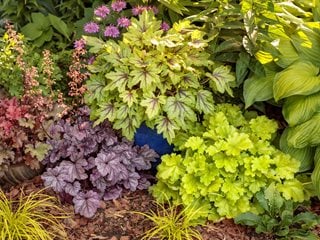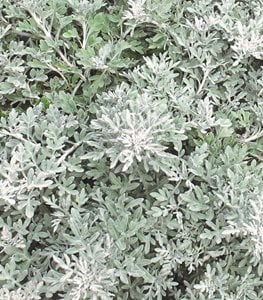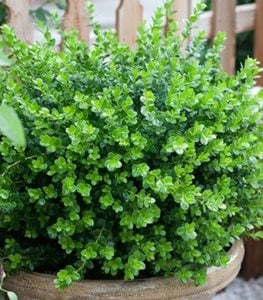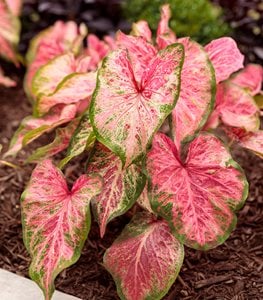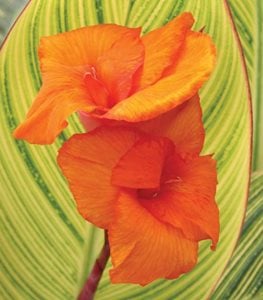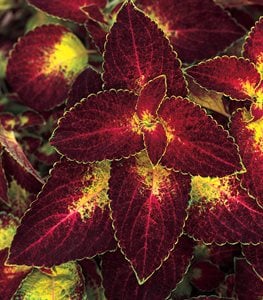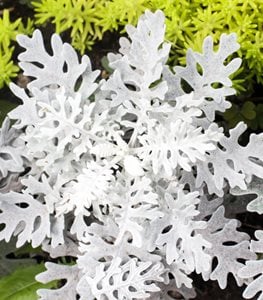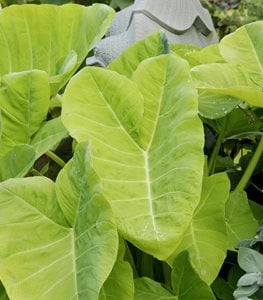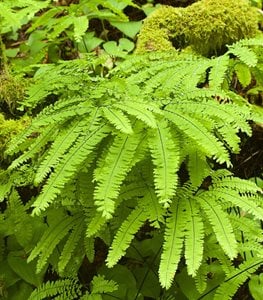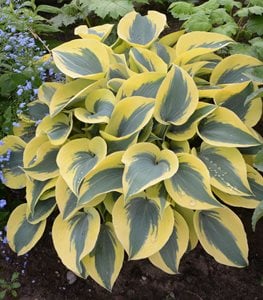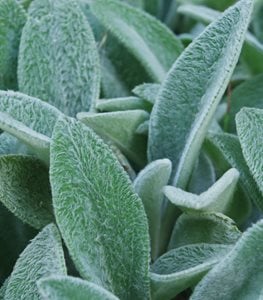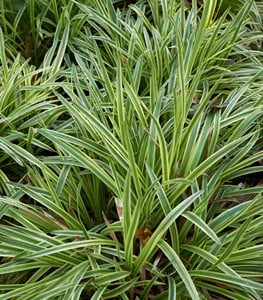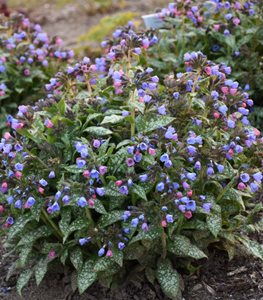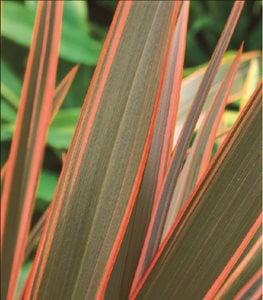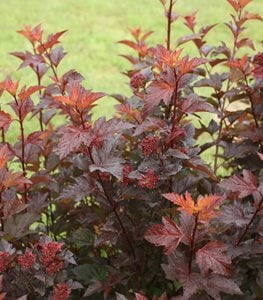Best Outdoor Foliage Plants to Grow
Add plants with interesting foliage to your landscapeFeatured in: Garden Design's Top 9 Garden Trends for 2023 ("Adding Texture with Foliage Plants")
When choosing plants, gardeners usually think of flowers first. Often overlooked are plants with foliage interest, which adds a different component to the landscape.
There are many kinds of annuals, perennials, shrubs, and trees that provide leaf color throughout the growing season. Foliage can be an effective background element or take center stage.
Look for foliage attributes such as color, variegated patterns, leaf shape and texture. Some varieties change hues throughout the year, while others exhibit spectacular fall color. Think about how different plants will look together and how foliage complements other features such as flowers, berries, fruit, and bark.
ALSO: Designing With Foliage Over Flowers
Here are some plant suggestions to get you started:
ARTEMISIA (Artemisia spp.)
Plant type: Herbaceous perennial, also grown as an annual
Zones: 3-9
Exposure: Full sun
Habit: Upright, mounding, or spreading habit
Height/Spread: 1 to 6 feet tall, 1 to 12 feet wide
Also known as wormwood or mugwort, Artemisia is grown for the silver, white, or gray foliage. The pungent aromatic leaves are deeply lobed or finely dissected, adding soft texture to the landscape. Use as a background plant in a mixed border, as an accent in a rock garden or herb garden, or in containers in combination with other plants.
Read more about growing artemisia.
Proven Accents® Silver Bullet® artemisia from Proven Winners, pictured.
BOXWOOD (Buxus spp.)
Plant type: Evergreen shrub
Zones: 5-9, with a few varieties hardy to Zone 4
Exposure: Full sun to shade
Habit: Dense bushy or upright habit
Height/Spread: 1 to 20 feet tall, 2 to 8 feet wide
Boxwood has long been used in formal European design as clipped hedging or living sculpture. The small leaves and compact habit lends itself to being pruned into neatly manicured shapes, adding structure to the landscape. Use boxwood as hedging to define garden rooms, as sculptural focal points, in containers, along pathways, or as a privacy screen.
Read more about growing boxwood.
Sprinter® boxwood from Proven Winners, pictured.
CALADIUM (Caladium bicolor)
Plant type: Tropical summer bulb
Zones: 9-11, grown as an annual in colder zones
Exposure: Partial to full shade
Habit: Upright spreading habit
Height/Spread: 12 to 24 inches tall, 8 to 24 inches wide
Also known as angel wings, Caladium are grown for the bold arrowhead-shaped leaves which come in an array of intricate patterns and colors. This shade lover can be used to brighten darker areas of the yard. Use as a bedding or container plant. Combine with other shade plants such as ferns, hosta, coleus, or impatiens.
Read more about growing caladiums.
Heart to Heart® ‘Blushing Bride’ caladium from Proven Winners, pictured.
CANNA (Canna spp. and hybrids)
Plant type: Summer bulb
Zones: 7-11, grown as an annual in colder zones
Exposure: Full sun
Habit: Upright habit
Height/Spread: 1-1/2 to 8 feet tall, 1-1/2 to 6 feet wide
Large banana-like leaves occur in shades of green or striking colored patterns, lending an exotic feel to the landscape. The plants, which are grown from rhizomes, also produce brightly colored flowers from summer into fall. Mass in beds or borders, use in containers, as a stand-alone focal point, or in combination with other heat-loving varieties.
Read more about growing cannas.
COLEUS (Plectranthus scutellarioides, syn. Solenostemon scutellarioides)
Plant type: Tropical annual
Zones: 10-11
Exposure: Partial sun to shade
Habit: Mounding, upright, or trailing habit
Height/Spread: 6 to 36 inches tall, 12 to 36 inches wide
Coleus is a popular Victorian bedding plant grown for the foliage, which comes in an endless array of shapes and patterns, in hues from bright yellow to almost black. Grow this versatile tropical annual in beds or borders, containers, window boxes or hanging baskets. Combine with other plants such as fuchsias, begonias, or elephant ears for a dazzling summertime display.
Read more about growing coleus.
ColorBlaze® Dipt in Wine coleus from Proven Winners, pictured.
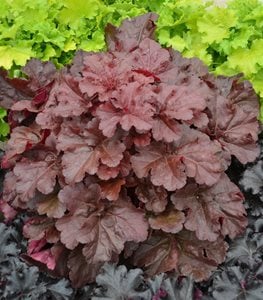
Primo® ‘Pretty Pistachio’, ‘Mahogany Monster’, and ‘Black Pearl’ coral bells. Photo by: Proven Winners
CORAL BELLS (Heuchera spp.)
Plant type: Perennial
Zones: 4-9
Exposure: Partial sun to partial shade
Habit: Mounding or spreading habit
Height/Spread: 6 to 18 inches tall, 12 to 30 inches wide
Named for the nodding bell-shaped flowers, coral bells are primarily grown for the evergreen or semi-evergreen foliage, which comes in a range of colors and shapes. This versatile perennial is tolerant of different light and soil conditions and needs little maintenance, making it virtually foolproof even for beginning gardeners. Use in a woodland border, as a ground cover, pathway edging, or in containers in combination with other plants.
Read more about growing coral bells.
Primo® ‘Pretty Pistachio’, ‘Mahogany Monster’, and ‘Black Pearl’ coral bells from Proven Winners, pictured.
DUSTY MILLER (Jacobaea maritima, syn. Senecio cineraria)
Plant type: Herbaceous perennial, usually grown as an annual
Zones: 7-10
Exposure: Full sun to partial shade
Habit: Upright bushy habit
Height/Spread: 6 to 24 inches tall and wide
Grown for the velvety silver foliage and delicate lacy texture, dusty miller goes with a wide range of color palettes, from soft pastel hues to bold tropical colors. It is most often grown as an annual and performs best in full sun. Use as a background plant in a mixed border, mass as a bedding plant, or place in containers in combination with flowering annuals.
ELEPHANT EAR (Colocasia spp.)
Plant type: Bulb
Zones: 8-11
Exposure: Full sun to partial shade
Habit: Upright vase-shaped habit
Height/Spread: 2 to 8 feet tall, 1 to 8 feet wide
Giant heart-shaped leaves up to 2 feet across resemble elephant ears, hence the common name. Foliage occurs in colors of green, purple, or nearly black, some with striped or speckled patterns. In colder climates, the large bulbs can be dug and stored indoors to replant the following spring. Use in containers or plant in beds with other tropical looking plants such as canna lilies, coleus, or sweet potato vines.
Read more about growing elephant ear plants.
FERNS
Zones: 3-11
Exposure: Partial sun to shade
Habit: Varies by genus and species
Height/Spread: Varies by genus and species
One of the most valuable plants for shade gardens, ferns add a lushness to borders, beds, and containers. Plants can range from tiny forest floor specimens to giant tropical tree ferns. Foliage is usually green, but can also occur in shades of silver, white, gold, orange, or purple. Sword-shaped leaves with finely dissected edges complement a wide range of shade-loving groundcovers, perennials, and shrubs.
Read more about growing ferns.
HOSTA (Hosta spp.)
Plant type: Perennial
Zones: 3-9
Exposure: Partial or dappled shade
Habit: Mounding spreading habit
Height/Spread: 2 inches to 4 feet tall, 5 inches to 6 feet wide
One of the most popular perennials for shade gardens, the bold leaves of hosta come in an array of colors, patterns and shapes. Plant size ranges from tiny thumbnail specimens to varieties as big as truck tires. Hostas are exceptionally hardy and reliable, combining well with other woodland plants such as ferns, coral bells, and bleeding heart. Grow in containers, woodland borders, or mass plantings.
Read more about growing hostas.
Shadowland® 'Autumn Frost' from Proven Winners, pictured.
LAMB'S EAR (Stachys byzantina)
Plant type: Herbaceous perennial
Zones: 4-9
Exposure: Full sun to partial shade
Habit: Mounding spreading habit
Height/Spread: 6 to 18 inches tall, 12 to 36 inches wide
Grown for the silvery foliage with a soft fuzzy texture that resembles lamb’s ears, hence its common name. Native to the Mediterranean, plants grow best in full sun and well-draining soil, and are drought-tolerant once established. Use as a quick-growing groundcover, border or pathway edging, or as a rock garden specimen.
Read more about growing lamb's ear.
LILYTURF (Liriope spp.)
Plant type: Grass-like evergreen herbaceous perennial
Zones: 4-10
Exposure: Full sun to partial shade
Habit: Mounding clumping habit
Height/Spread: 8 to 24 inches tall and wide
Strappy green or variegated leaves add fine texture and structure to the landscape. Purple, pink, or white flower spikes appear in late summer. This quick-growing ground cover is drought tolerant and low maintenance once established. Mass along a slope for erosion control or use as pathway or border edging. Makes a good substitute for turf lawn in areas without regular foot traffic.
LUNGWORT (Pulmonaria spp.)
Plant type: Herbaceous perennial
Zones: 3-9
Exposure: Partial to full shade
Habit: Mounding spreading habit
Height/Spread: 6 to 12 inches tall, 1 to 2 feet wide
Grown for the lance-shaped leaves that are green, silver, speckled, or patterned. Clusters of bell-shaped flowers appear in early spring, occurring in hues of blue, pink, or white. Plant this shade lover in a woodland garden alongside hellebores, bleeding heart, hosta, and spring blooming bulbs for a dazzling early season display.
Read more about growing lungwort.
'Pink-a-Blue' from Proven Winners, pictured.
NEW ZEALAND FLAX (Phormium tenax)
Plant type: Evergreen perennial
Zones: 9-11
Exposure: Full sun to partial shade
Habit: Upright spiky habit
Height/Spread: 1 to 12 feet tall, 1 to 6 feet wide
The thick sword-like foliage of New Zealand flax lends bold structure and texture to the landscape. Leaves come in shades of green, burgundy, orange, red, pink, and gold, some with bicolor or pinstripe patterns. Use as a focal point in a container or the landscape. Potted specimens can be overwintered indoors in colder regions.
NINEBARK (Physocarpus opulifolius)
Plant type: Deciduous shrub
Zones: 2-8
Exposure: Full sun to partial shade
Habit: Upright arching or bushy habit
Height/Spread: 3 to 10 feet tall, 3 to 12 feet wide
Ninebark has multi-seasonal appeal. The lobed round or oval foliage comes in shades of green, purple, burgundy, gold, orange, or multi-hues. Some varieties have new foliage growth that changes color as the season progresses. This carefree shrub can be planted in mixed borders, as hedging or screening, or used as a focal point in the landscape.
Read more about growing ninebark.
Ginger Wine® ninebark from Proven Winners, pictured.
ORNAMENTAL GRASSES
Plant type: Perennial
Zones: 3-11, depending on genus and species
Exposure: Full sun to partial shade
Habit: Upright, mounding, or spreading habit
Height/Spread: Varies by genus and species
Ornamental grasses add texture, movement, and sound to the landscape. There are dozens of varieties to choose from in different colors, sizes, and shapes. Foliage is often accompanied by attractive seedheads that occur from late spring to fall, depending on the variety. These reliable plants are virtually maintenance free, adding winter interest and providing food and shelter for wildlife.
Read more about growing ornamental grasses.
REX BEGONIA (Begonia rex-cultorum)
Plant type: Tropical perennial
Zones: 10-12
Exposure: Part to full shade
Habit: Upright mounding habit
Height/Spread: 8 to 24 inches tall and wide
Also known as fancy leaf begonia, these delicate looking plants are valued for their highly decorative leaves, which come in a wide range of colors and patterns. These flamboyant tropical perennials can be grown outdoors in warmer months and treated as annuals, or overwintered indoors as houseplants. They are most often displayed in containers or terrariums, but can also be used as bedding plants in shady areas.
Read more about growing begonias.
See more on the Proven Accents® line of foliage plants from Proven Winners, get container recipes and planting ideas.
RELATED:
Top 15 Evergreen Shrubs
Evergreen Trees for Residential Gardens
20 Great Shade Plants
Purple-Leafed Plants
